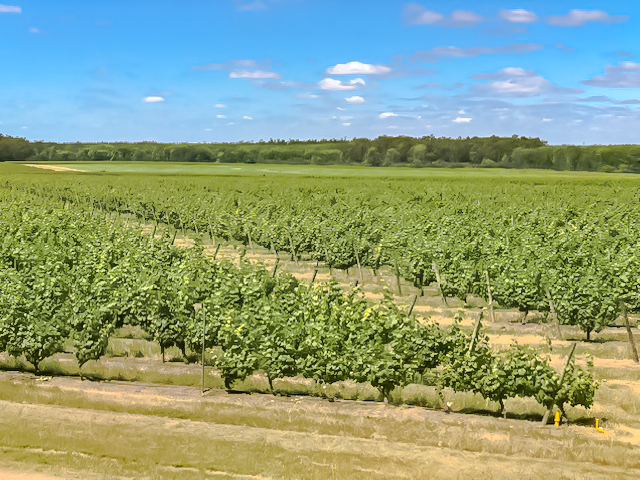December 5, 2019:

Today is our last full day on the Mariner, and Jim and I are determined to enjoy every moment. We docked first thing today in the port of Montevideo, Uruguay. This is the capital city of Uruguay, and Jim and I spent some time here in 2015 when we were touring South America. Since we have already seen most of the tourist highlights in town, we opted to go out into the nearby countryside to visit one of the local wineries, Juanico, which are attracting some buzz in the wine world. Our tour did not leave until early afternoon, which gave us some time to enjoy a last leisurely breakfast in the dining room, and to begin packing to go home tomorrow from Buenos Aires. From the ship, we can see the port area bustling with activity.

Then it was time to leave for our tour. Until the1980s, Uruguay did not have much of a vineyard culture. The country was probably best known for producing cognac (or aguardiente), and that in huge commercial quantities. However, the local vintners discovered that a grape varietal from France called Tannat did quite well in Uruguay’s somewhat humid climate, and they started planting acres of it.


Fast forward thirty years, and the bulk production of cognac has almost entirely disappeared, while the local farmers have expanded their vineyards to include many other varietals. The vintners are also modifying the growing techniques to evolve their fields from vine structures which promoted greater quantities of grapes grown on v-shaped supports, to one which features more traditional trellised vines supported by single wires such as we see in most of the United States. We drove out into the vineyards to see these changes, and to observe the grapes growing. It is interesting that even the grape sizes and clusters appear somewhat different than those with which we are more familiar in the northern hemisphere.


Following our visit to fields, we visited the wine production facilities, which in this case had started out with a somewhat futuristic-looking circular concrete wine storage facility built in the 1960s to age the cognac then being produced. I don’t know about you, but it kind of looked like a spaceship for wine to us!



We concluded our tour with a visit to the cellar on this property, which began life as a religious mission back in 1745. Then we gathered to taste the wine of Juanico. We started with a very crisp sparkling wine produced in the methode champenoise, which we all enjoyed very much. That was followed by a sample of a white blend made using both Chardonnay and vi9gnier grapes. We liked it but preferred the Sparkling wine. The3n they let us taste a wine made from a grape varietal none of us had every heard of; called Marselam. Jim liked the taste and mouth-feel, but found the aroma offputting. Finally, we tasted our favorite of the group, a Tannat from their flagship brand called Don Pascual. Unlike several other Tannat wines we tasted five years ago, Jim and I found this to be much smoother and well-rounded than the Tannats we had sampled before. Juanico had provided a lovely charcuterie platter to pair with their wines, and the tannins in the Tannat greatly benefitted from the addition of some salami on your tongue. Finally, we tasted a Cabernet Franc Cabernet Sauvignon blend which was clearly targeted towards North American wine palates. Although it was good, it was not worthy of its $55 price tag, particularly when all the other wines were retailing for between $11 and $17 dollars. Had we been staying on the ship a few days longer, we would have bought a couple of the Tannats to bring back, but it was not to be.






Instead, Jim and I finished packing, and enjoyed a last meal with some newfound friends aboard the Mariner. Tomorrow, we return to Buenos Aires to spend a whirlwind day touring, before our late night flight home. Stay tuned for the final chapte3r in this episode of the Gringo travels!


